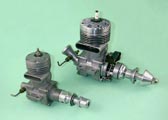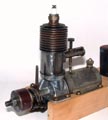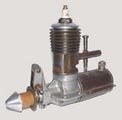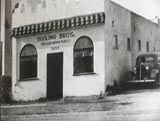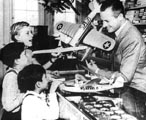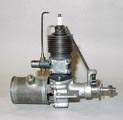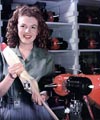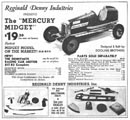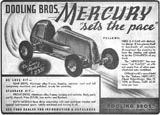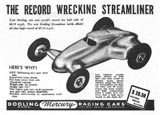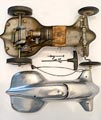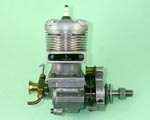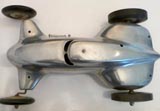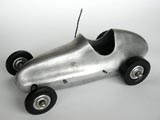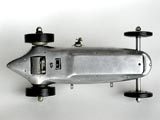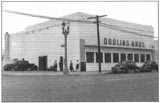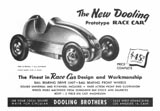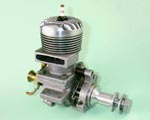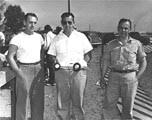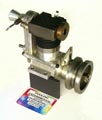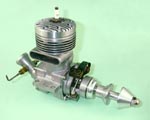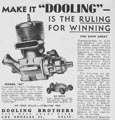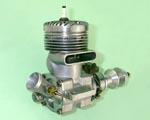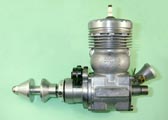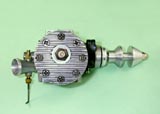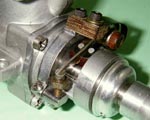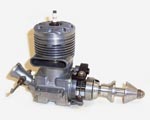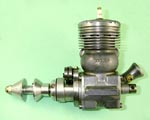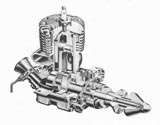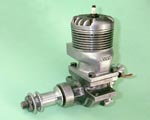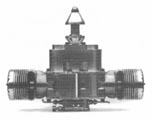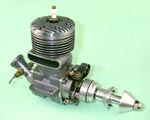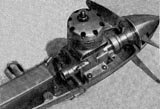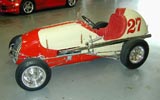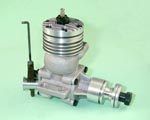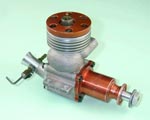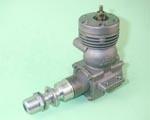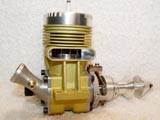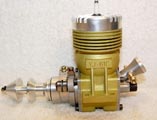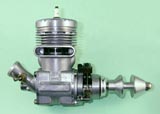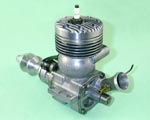The Dooling story Part 1
Tether cars and the Dooling 61
by Adrian Duncan
-
 Background
Background -
 The Establishment of the Dooling Brothers Company
The Establishment of the Dooling Brothers Company -
 The Early Post-War Period
The Early Post-War Period -
 1947: The Dooling .61 Appears
1947: The Dooling .61 Appears -
 Market Reaction to the Dooling 61
Market Reaction to the Dooling 61 -
 The Impact of the Dooling 61 in Britain
The Impact of the Dooling 61 in Britain -
 Experiments With Nitromethane
Experiments With Nitromethane -
 The Exhaust Stack Controversy
The Exhaust Stack Controversy -
 The Final Dooling Car—the Arrow
The Final Dooling Car—the Arrow -
 The Bruce Underwood Yellow Jacket Project
The Bruce Underwood Yellow Jacket Project -
 Conclusion
Conclusion
The name Dooling is truly legendary among aficionados of classic model racing engines. In a pair of articles of which this is the first, we'll attempt to provide a summary of the model-related activities of the family which created the Dooling legend—the Dooling brothers Russell, Harris and Tom. This first article will cover the period up to 1949 during which the famous Dooling 61 was created. We'll deal with the 29 in a subsequent article.
The Dooling brothers are most widely remembered today for the fine .29 cuin. and .61 cuin. racing engines which they manufactured during the early post-WW2 period. However, their impact upon the modelling hobby extended well beyond the design and manufacture of racing engines—in a very real sense, they may be regarded as the initiators of the sport of model I/C-powered car racing.
My research into this very interesting subject was greatly facilitated by reference to a number of fine publications assembled during the 1970's by the late Arthur G. Suhr of Menomonee Falls, Wisconsin, USA. These included "Antique Model Gas Engines", "Model Engine Reviews", "The Glow Plug Model Engine" and lastly "Miniature Racing Cars". These collections contained scans of numerous advertisements and articles relating to their respective subjects which form an invaluable reference for anyone undertaking research in this area. It's my pleasure to acknowledge the immense debt that we all owe to Art for his hard work in making these publications available.
I'm also indebted to the late David Janson, whose four-part write-up on the Dooling engines appeared beginning in October 2001 in issues 148-151 of the Engine Collector's Journal which is so ably edited by our good friend Tim Dannels. David had the opportunity to speak with Russell Dooling's son, the Rev. Bob Dooling of Loveland, Colorado, thus gleaning many interesting background facts about the Dooling family and its activities. I freely acknowledge my debt to David for generously sharing this information with us.
To fully appreciate the contribution of the Dooling brothers to the development of the small engines that we all find so fascinating, we'll have to wind the clock back to the nineteen-thirties and spend some time delving deeply into the world of model car racing for the ever-essential background. Let's get right to it!
Background
Although a limited number of small I/C engines potentially suitable for model use had been offered for sale in various parts of the world from 1909 onwards, the 1931 introduction of the Brown Junior spark ignition motor in the USA is generally considered to mark the first step towards the true commercial-scale manufacture of model engines worldwide. The first dozen or so engines were individually constructed by Bill Brown in his home workshop, but by 1934 the 10 cc Brown Junior "B" was in full-scale production by Junior Motors of Philadelphia, Pennsylvania. Despite the fact that the Great Depression was still in full swing at the time, the Brown was developed quite rapidly and was quickly challenged by a number of rival products, predominantly manufactured in the USA.
Prior to 1937, the majority of model engines were used to power large free flight model aircraft. Since these models were uncontrolled following launch, attempts to achieve high speeds would have been potentially hazardous, to say nothing of the difficulty of obtaining accurate speed measurements. However, the human race being the competitive species that it is, the above limitations did not prevent contests for power model aircraft from becoming quite fashionable among serious modellers.
During these early stages of powered model aircraft development, performance-oriented competitions were based strictly upon flight duration. The first priority was simply to get the model into the air, and the second was to keep it up there as long as possible on a given engine run. Since allowable running time was then considerably greater than it is today, all-out engine power was less critical at this stage than dependability and consistency in operation. Light weight was also an important factor. Although tethered hydroplane racing was taking place during this period, its popularity did not match that of model aircraft. Moreover, most consistently successful hydro practitioners tended to make their own specialized powerplants. There was thus little stimulation for the commercial development of all-out model racing engines at this stage.
As a result of this situation, those modellers having an interest in all-out engine performance found their attention drawn towards other forms of power modelling in which the full output of their engines could be utilized. The development of tethered model aircraft operation (aka control line), which allowed the safe attainment of high speeds under full control while also facilitating accurate speed measurement, still lay some years in the future. However, the tethered operation of model hydroplanes was already well demonstrated, and it required only a short stretch of the imagination to envision the same approach being applied to model cars. As matters turned out, the Dooling brothers were the individuals who possessed both the required imagination and the necessary skills.
The Dooling family originally hailed from Alton, Illinois. During the early years of the Great Depression which began in 1929, Thomas E. Dooling moved with his wife and three sons to the Los Angeles area, hoping to find better employment opportunities there. As a result of this move, the three Dooling brothers completed their schooling in the Los Angeles area during the early to mid 1930's. All three brothers attended Manual Arts High School, acquiring a variety of technical skills during their time at that institution.
After successively leaving school, the brothers did what everyone had to do during that difficult period—they took work wherever they could find it, including such diverse places as the local film studios and oil rigs. In their spare time they were keen model airplane enthusiasts, leading them to join with many other local hobbyists in flying their models at the Los Angeles Model Airplane Field in Gardena at the intersection of Rosecrans and Western Avenues (known to contemporary modellers as the Dust Bowl for reasons which are perhaps best left to the imagination!).
We're fortunate indeed that Tom Dooling left a brief but very clear contemporary record of the manner in which the interests of the three brothers became diverted away from model aircraft towards model car racing. Tom's article on this very subject appeared in the June 1940 issue of "Model Craftsman" magazine along with a photo of Tom with his race-winning car and trophy.
Tom recalled that he was typical of most amateur aerodynamicists at the time in that while he usually managed to bring his model back home on a Sunday evening, it was generally in pieces (been there, Tom, done that!). On one particular Sunday evening in early 1937, Tom was sitting with his brothers round the fire after a winter flying session at the Dust Bowl. While contemplating the remains of Tom's latest aeronautical mishap, the idea came to the brothers that perhaps Tom's engine (a Bunch Gwinn-Aero unit) could be put to better and possibly less destructive use in a model car of some kind. Tom had apparently seen a model car which had been constructed by the film star and keen model enthusiast Reginald Denny. He believed that he and his brothers could do better!
Since the Dooling boys were always attracted to any activity which involved tinkering with mechanical objects, little time was lost in putting this idea into practise. During the following week, the three brothers assembled their first-ever model car, using Tom's existing Bunch Gwin-Aero engine as the powerplant and employing front wheel drive with bevel gearing. Tom characterized this initial model as having "the beauty and grace of a one-legged duck—and with all its ugliness"! Still, it worked reasonably well, as subsequent tests showed.
The car's initial appearance at the Dust Bowl drew mixed reviews from the Dooling brothers' fellow model airplane enthusiasts. The vehicle's performance was somewhat marginal at this stage, leading some observers to ridicule their efforts. However, a number of others were able to see past the shortcomings of this first effort and realize that these shortcomings were more down to lack of development than anything else. These individuals expressed interest in making their own attempts at building cars, and a new branch of the modelling hobby was born.
Despite its various failings, that first model car had demonstrated the basic soundness of the design approach which it embodied. Having learned from their first effort, the Dooling brothers began immediately to draw up a design for an improved version of the vehicle. Others followed suit, and soon there were enough operational cars in the greater Los Angeles area that unofficial model car race meetings began to take place on an abandoned lot in Los Angeles.
The Establishment of the Dooling Brothers Company
Over the following year, the Dooling brothers continued to develop their basic design. Their original workshop was in the garage at their parent's home, but at some point they went into business on a commercial scale by establishing their first independent manufacturing facility at a location which remains unclear at this point in time. The name of this facility was Dooling Bros. Precision Machine Products. A surviving photograph of the building shows that it bore the street address 5894, although the actual street name appears to be lost. Since there is no record of model cars or engines ever being sold from such a street address, it's clear that this must indeed be the original Dooling Bros. shop, as the image caption claimed it to be.
By the latter part of 1938 the Doolings finally had a model that they felt could be successfully offered to the public on a commercial basis. The country was by then pulling out of the Great Depression, the result being that people were once again beginning to feel good about spending money on hobbies. Moreover, the model car racing movement had gained momentum, the result being that the number of participants had grown to the point where the involvement of commercial interests was becoming a viable proposition. Tom had maintained contact with Reginald Denny, whose car had actually inspired it all. Denny was sufficiently impressed with the Doolings' prototype efforts that he made a commitment to market all that the brothers could make.
Reginald Denny was an interesting character. Born Reginald Leigh Dugmore in 1891 in Richmond, Surrey, England, he relocated to the USA following service in WW1 as a Lieutenant in the Royal Flying Corps. The acting career which had begun in England when he was only 8 years old blossomed in America, first in New York and later in Hollywood. During the 1920's he maintained his aviation activities by periodically performing as a stunt pilot in between movie roles.
In the early 1930's Denny became interested in the then-new concept of radio control for model aircraft. In partnership with several others, he formed Reginald Denny Industries in 1934, also opening a hobby shop at 5751 Hollywood Boulevard in Los Angeles under his own name. At the same time Denny pursued the concept of radio controlled miniature aircraft to the point where a prototype target drone, the RP-1 (Radio Plane 1), was demonstrated to the U.S. Army in 1935.
In 1937 Denny established a business relationship with Walter H. Righter, who designed and produced the Dennymite line of model engines along with a number of matching model aircraft known by such names as the "Dennyplane", the "Dennyplane Junior" and the "Denny Bullet". It was during this period that Denny became aware of the activities of the Dooling brothers. However, although his hobby shop remained very much in business at this time, his personal interest was becoming increasingly focused upon his drone development activities. He established a separate business entity called the Radioplane Company which produced improved prototypes designated the RP-2, RP-3 and RP-4 with the ongoing involvement of Walter Righter on the design and technical side.
The RP-4 first flew in 1939, attracting immediate interest from the U.S. Army, which placed an order in 1940 for 53 of these aircraft, which they re-designated as the OQ-2 Radioplane (OQ being military code-letters for a sub-scale target). A far larger order was soon placed following America's entry into WW2, along with a separate order from the U.S. Navy. These small unmanned aircraft were powered by a compact opposed twin-cylinder two-stroke engine. They were manufactured in a facility located at Van Nuys Airport in Los Angeles. One of the employees was a young lady named Norma Jeane Dougherty, later far more famous as the film star Marilyn Monroe.
The Radioplane company went on to manufacture over 15,000 drones during WW2. The highly successful business carried on after the war, eventually being sold to Northrop Aviation in 1952. Denny himself continued his acting career, eventually passing away in 1967 at the age of 75.
Returning to 1938, the Dooling brothers were sufficiently encouraged by Reginald Denny's interest in their car design that they took the plunge by establishing expanded manufacturing facilities at 3433 West 59th Street, Los Angeles, California. The company name (logically enough) continued to be Dooling Brothers. There was a well-marked division of responsibilities—Russell (the eldest) was a gifted inventor, designer and draftsman, hence taking charge of product development; Harris (the next oldest) was the most talented machinist of the three, accordingly taking a lead role in production; while Tom (the youngest) was the expert tester and racer who had a gift for salesmanship, thus handling the demonstration, promotion and marketing chores. This was very much a team effort.
The first production model race car to be manufactured by the company made its initial advertising appearance in December 1938. This was the Mercury Midget, a model best known to present-day collectors of model race cars as the First Series Front Drive.�It retained the front wheel drive and bevel gearing of the original prototype. With the right engine fitted, it proved to be a very competitive model by the standards of the day. The car was distributed by Reginald Denny through his Los Angeles hobby shop.
By this time, the sport of model car racing had expanded well beyond the Los Angeles area. In a separate article on this site, we have traced the development of the "classic" model racing engine from the appearance of the A.C. Special in 1938 in Oakland, California to the adoption and refinement of that design as the Hornet 60 beginning in 1939 in Fresno, California. Both of these designs were inspired by the power requirements of model race cars as opposed to aircraft.
Fresno quickly became a major venue for model car racing, thanks in large part to the efforts of Ray Snow of the Hornet Motors Co. The first major officially-sanctioned model car race meeting of them all was held in Fresno in May 1939. The Dooling brothers attended this meeting, still apparently using Bunch powerplants. Tom Dooling recalled that their success at this event was such that they decided there and then to attend every future model car race meeting to which they were able to travel.
The Dooling car models were evidently well received, to the extent that the brothers were encouraged to continue the development of their products. In October 1939 they expanded their range by releasing the Deluxe Mercury Midget. This was an all-aluminum rear-wheel drive version of the Mercury Midget design which was usually referred to simply as the Dooling Rear Drive.� It quickly proved its worth by establishing a new record speed of 62.23 mph at a meeting held at Fresno on November 19th, 1939 in the hands of Chuck Felgentrager. The original front drive model remained in production, with both models continuing to be distributed by Reginald Denny along with Walter Righter's Dennymite engines. Logically enough, many of these early Dooling cars were Dennymite-powered.
Throughout this period, the brothers continued to compete at every meeting which they could attend. In his previously-mentioned June 1940 "Model Craftsman" article, Tom Dooling recalled that his best speed on a flat track over the timed quarter-mile up to that time was an average 63.83 mph. This speed was achieved on March 3rd, 1940 at an unofficial meeting of the Wheel Twister Club in Van Nuys, California. A week later, on the banked track at the Los Angeles Speedway, Tom's average speed over a timed mile was 61.9 miles per hour.
At some point in early 1940 the distribution agreement between the Dooling brothers and Reginald Denny ended, likely because by this time Denny was very much focused upon his Radioplane Company which was then on the brink of achieving great success as a supplier to the U.S military. From this point onwards, the brothers marketed their products themselves with no middle-man. Tom Dooling remained the mainstay of the brothers' promotion and marketing efforts.
The Mercury series continued to evolve in October 1940 with the release of a refined version of the original front wheel drive model. This car is usually referred to by present-day collectors as the Second Series Front Drive.� In the opinion of many, it was the most attractive of the Dooling race cars. This model was typically powered by either a Dennymite or a Super-Cyclone engine.
All of the models in the Mercury series had borne a general resemblance to a typical upright, open-cockpit full-sized midget race car of that era. In addition, they had all employed bevel gearing, like all of their commercial competitors of the day. However, all this changed in March 1941, when the Dooling brothers really set the miniature car racing hobby on its ear by introducing the Streamliner, a uniquely-styled car which competitors soon affectionately dubbed the "Frog" on account of its squat, "splay-legged" appearance.�The Streamliner certainly had a striking low-slung style of its own, quite unlike any full-sized prototype.
Most significantly, the Frog was the first spur-gear driven model race car to be produced and sold commercially.�The car was driven by a transversely mounted horizontally-oriented engine with spur gears arranged on a system which eliminated the need for a drive shaft. The entire motor mount assembly, including the drive-axle, could be lifted out of the car by removing just four screws located beneath the belly pan. The cast aluminum body separated to reveal a two-piece front axle. By virtue of a torsion bar system, each spring-loaded front wheel assembly could be individually adjusted for ride height to suit varying track conditions. Both axles were locked down by hexagon nuts after adjustment. The car weighed only 48.75 ounces ready to race. Many of these cars were powered by the Hornet 60 engine, which was then (1941) the most powerful commercially-available motor in America.
Not unnaturally, the radical appearance of the Frog inspired a considerable degree of controversy among those who believed that a model race car should resemble a full-sized prototype, at least superficially. However, these voices were quickly silenced by the car's performance, which was nothing short of spectacular. On its initial competitive outing in the capable hands of Tom Dooling, it demolished all applicable track records, including the establishment of a new outright world record speed at 87.12 mph. Some going for 1941, and quite an improvement over Tom's 1940 speeds! The way to the future of model car racing had been very clearly pointed out for all to see.
During this period, the pre-eminent sanctioning body for gas powered miniature car racing in the United States was the American Miniature Car Racing Association (AMCRA). At the time of which we are now speaking, this body was operating under a set of rules which recognized two classes, based upon the displacement of the engine used in the model.� One class was restricted to cars using engines of up to .36 cuin. displacement (the ".36-class") while the second class was open to models using engines having displacements ranging from .36 cuin. to .625 cuin. (the ".60-class").
Considerations of cost and complexity made it readily apparent that the encouragement of new blood into the sport would be well served through the promotion of the smaller and far cheaper .36-class. Accordingly, persistent attempts were made to encourage participation in this category. However, the majority of serious competitors made it clear that they wanted none of it.� As a result, virtually all of the really competitive model car racers of the era competed in the larger .60-class, the likes of Dick McCoy, Bill Atwood, Ira Hassad and Ray Snow being among them. Racing engine development accordingly remained very much focused upon the .60 category.
Despite this, a few die-hard proponents of the smaller .36-class remained true to their principles, soldiering on in their efforts to encourage newcomers to the hobby to build and race these far less expensive cars with their smaller displacement engines.�Unfortunately, competitive commercially-available .36-class cars were relatively few, being limited to the Peerless, the Hulse Hustler and a number of home-built cars. The latter were generally constructed from plans published in national magazines as a means of encouraging participation in the smaller displacement class.
It was into this seemingly unpromising market environment that the Dooling brothers introduced what they called their "Small Class Conventional Racing Car—Series 6000" in November, 1941.�The editor of "Model Craftsman" magazine had been badgering manufacturers to produce more cars capable of being competitive in the .36-class, and now his efforts had begun to bear fruit.� Who better to establish the credibility of the smaller displacement cars as truly competitive racers than the now-famous Dooling brothers?
Like its predecessors, the name of the Series 6000 was quickly replaced with a nickname by which it became far better known—in this case, the PeeWee. It would be difficult to find a model car collector today who would refer to the car as a Dooling Series 6000!
The 12-inch long Dooling PeeWee bore a strong external resemblance to a scaled-down version of the earlier Second Series Front Drive car.�However, inside it was a very different story. The engine was mounted with its cylinder in a horizontal orientation with the cylinder head pointing toward the front of the car. The rear axle was powered through a friction drive taken directly off the engine crankshaft onto the left rear wheel.�The floating front axle was mounted to the pan with a single coil spring.�
The PeeWee was sold in kit form at a list price of $16.95, less engine.�The kit included a two-piece cast aluminum body which was fully machined and polished as supplied.� The kit also included the cast aluminum front axle and motor mount, as well as the front and rear axle studs.�All necessary hardware was also included, including the solid rubber tires, chrome plated wheel halves, front axle spring, and all other items needed to complete the assembly of the car. Detailed assembly instructions accompanied the kit, including recommendations for fabrication of the fuel tank as well as installation of the coil, condenser, battery pack and bridle.
Even though the car was specifically designed to compete in the .36-class, the assembly instructions noted that the car was suitable for use with engines ranging in size from .23 cuin. to .45 cuin.� The instructions also noted that, to be compliant with AMCRA rules in effect at the time, the car should weigh a minimum of one pound per 1/10 cubic inch displacement of the engine used to power the car.�To satisfy this requirement, Dooling recommended adding as much lead as necessary to the tail end of the car.
In their early advertisements for the PeeWee, Dooling claimed that the car had exceeded 70 mph using a "strictly stock Bunch Tiger".� However, the use of the .45 cuin. Bunch Tiger would have placed the car in the larger .60-class, where it would not have been competitive against adversaries running with much larger engines of the Hornet and McCoy breed.� As a result, most Dooling PeeWees which were actually raced were equipped with Forster .29 or Phantom P-30 engines.
Like all other Dooling race cars, the Dooling PeeWee was a beautifully designed and well-engineered product which was manufactured to exceptional standards.� However, for reasons beyond their control the Dooling brothers did not enjoy the same success on the race track or at the cash register with the PeeWee which they had experienced with their previous cars and which they were to enjoy with their post-war F-car and Arrow.
The major factor affecting the fortunes of the Peewee was the timing of its introduction, only a month prior to the entry of the United States into WW2. Naturally, this unhappy event caused a sharp waning of interest in gas-powered model car racing, particularly in the hitherto unloved .36-class.� As a result, the impact of the Dooling PeeWee on the popularity of the .36-class proved to be negligible, leaving many PeeWee kits languishing on the shelves of hobby shops across the country.
The onset of WW2 inevitably brought great changes to the activities of the Dooling brothers. The model car manufacturing business had been very successful, with some 1300 cars having been sold in the pre-war era according to David Janson's research. However, the former model car racing fraternity now had other matters on their minds. Moreover, the aluminium and magnesium alloys used in the construction of the cars were now needed for defence production, as were the capabilities of the Dooling Brothers workshops. The brothers landed a number of lucrative defence contracts which kept them busy right through to late 1945. To assist them in this effort, they brought in a gifted individual named Johnny Gilchrest, who was to remain with the company long after the end of the war and become a key figure in the company's post-war activities.
During this period, no further work was undertaken on the model car front, although the Doolings doubtless dreamed of the day when they could resume their involvement with that activity. Their eventual return to former activities was greatly facilitated by the fact that the scale of Dooling Brothers' wartime production programs both necessitated and financially justified a move to larger premises at 5452 West Adams Boulevard, Los Angeles 16, California. They were thus far better equipped at the end of the war than they had been at its outset.
The Early Post-War Period
Once freed from their wartime commitments, the brothers were quick to re-enter the model car field, being greatly assisted by the continuing presence of Johnny Gilchrest. In April 1946, they introduced the "F" car design, otherwise known as the Dooling Prototype. There has been much speculation regarding the basis for the use of the letter "F", ranging from the fact that each of the brothers had the same middle initial (standing in fact for the same middle name of Fowler) to the fact that the F model was the sixth Dooling design to be offered commercially. We'll probably never know for sure ... feel free to speculate!
The appearance of the "F" car was far closer to a full-size midget racer than the earlier Frog had been. The vehicle was sixteen inches long with a two-piece die-cast magnesium body. Once again, bevel gears were used to drive the rear axle. A separate, stamped aluminum Kurtis midget-type grille was riveted to the body top. The front axle was a two-piece cast aluminum knee-action design, supported by a bracket bolted to the belly pan. This resulted in independent suspension of the front wheels. Rubber grommets surrounding the axles provided more support at the body openings.
The F model appears to have sold quite well, hence being probably the easiest Dooling car to find today. These fine little models were supplied by the factory painted in many colour combinations. Optional tires and a revised front axle could be supplied for rail racing. Many examples were powered by the Hornet 60 engine from Fresno, California, where it had all started. At this time, a well-prepared Hornet could still give the original McCoy 60 a very good run for its money.
Prior to the onset of WW2 and immediately thereafter, the Dooling brothers had focused solely on the design and manufacture of model racing cars, relying on the ready availability of suitable engines from other manufacturers. The Hornet 60 remained the engine of choice until the post-war McCoy 60 began to appear in quantity in 1946 after its manufacture was take over by the DuroMatic Products Corp. Even then, the McCoy and Hornet were sufficiently closely matched that neither gained a decisive edge at this time.
It may have been a desire to break this deadlock and move racing engine performance to the next level that prompted the Dooling brothers to enter into an intensive program of model engine development beginning immediately following the termination of WW2 hostilities in 1945. However, it's interesting to note that at the outset they appear to have had no fixed development targets but instead elected to explore a broad range of designs having widely differing potential applications. One actually gets the impression that at this time they shared much with the proverbial kid in the sandbox!
Be that as it may, the range and ingenuity of the various prototypes which originated during this period was truly astonishing, placing the Dooling brothers at the forefront of the model engineering movement of their day. Over the next two years, the brothers reportedly produced no fewer than 33 different prototypes, nine of which were re-developed into additional satellite variants. The range of types investigated was astonishing, including four different four-stroke models (at least one of which was supercharged), a twin-cylinder unit and two additional two-stroke models which were equipped with fully functional superchargers. All of these prototypes were thoroughly tested on an electric dynamometer which the brothers had constructed for use in their own shop.
Thanks to the generosity of surviving members of the Dooling family, a number of these experimental engines may be seen today at the AMA Museum in Muncie, Indiana, USA. These include the aforementioned supercharged four-stroke, which reportedly reached 28,000 rpm—some going for a four-stroke! There's also a stepped-piston two-stroke model using a design concept which was to be experimentally revived by MVVS in 1956. Another gem of the collection is a four-stroke sleeve-valve model, although this one was reportedly a failure in performance terms, developing "negligible horsepower"! All of these fascinating creations may be studied at the Museum by appointment.
1947: The Dooling .61 Appears
The extensive testing and development program just described finally culminated in the mid 1947 appearance of the first model of the Dooling 61 racing engine, a motor which must surely rank as one of the all-time great model racing units. Oddly enough, this engine bore no resemblance whatsoever to any of the experimental models which had preceded it!
The Dooling 61 seems to have been released rather quietly in the Los Angeles area in mid 1947, presumably to confirm the engine's competitiveness prior to commencing a national advertising campaign. As far as we can determine, the first national advertisement for the new model appeared in the November 1947 issue of Model Airplane News, by which time the company already had a number of competition successes to report. The selling price of the engine was set at $35.
For some reason, there seems to be a general tendency among engine aficionados today to credit Tom Dooling with the designs produced by Dooling Brothers. However, we saw earlier that Tom's primary role actually appears to have been the testing, promotion and marketing of the company's designs while Russell was in reality the design wizard, with Harris leading the production side, ably assisted by Johnny Gilchrest. This division of responsibilities naturally made Tom the most visible of the brothers, which is doubtless why his name is the best-remembered of the three today. However, fairness to all concerned compels us to point out that most of the admittedly circumstantial evidence points to Russell Dooling as having been the primary designer of the Dooling 61 (and the later 29 for that matter). He certainly did the majority of the design drawings, as witnessed by his initials in the appropriate places.
Although its design generally followed the classic racing engine layout established by the A.C. Special and the Hornet 60 which was subsequently adopted by the McCoy 60 among others, the Dooling 61 displayed a number of design departures which really made it stand out from the rest. Let's have a closer look at this wonderful engine.
The Dooling 61 was at heart a typical big-bore racing motor by the standards of its day. It featured all of the "classic" features which had been established by the A.C Special and its Hornet successor, including cross-flow loop scavenging; an internally-contoured cylinder head with the plug displaced to the transfer side; a ringed aluminium alloy piston; a forged alloy con-rod; a twin ball-race crankshaft; and rear rotary disc valve (RRV) induction through a large-diameter venturi. As such, a fully comprehensive description seems unnecessary here. However, the engine incorporated some groundbreaking features which richly deserve our close attention.
The first factor that distinguished the new Dooling from its predecessors was its bore/stroke ratio. The new model was significantly more over-square than any of its earlier rivals, having bore and stroke measurements of 1.015 in (25.78 mm) and 0.750" (19.05 mm) respectively for a displacement of 0.607 cuin. (9.94 cc). The resulting bore/stroke ratio of 1.35:1 was unprecedented at the time. Checked weight with spark plug as well as the standard prop driver assembly was 15.59 ounces (442 gm), fractionally less than the competing Hornet and McCoy models in the same condition. Without the prop driver, the engine weighed 14 ounces (397 gm).
However, what really set the Dooling design apart from that of its predecessors was the bypass system. The Dooling 61 introduced the "bulge bypass" design for which the Dooling engines were to become both famous and highly influential. This system involves the provision of a large bulbous chamber in the normal bypass passage location. There is no direct communication between this chamber and the lower crankcase, such communication being arranged instead through the provision of three oversized oval ports in the piston skirt which align with matching ports in the lower cylinder liner at and near bottom dead centre. All of the transfer gas mixture thus has to pass through the piston interior into the bypass bulge, from which it is supplied to the cylinder through transfer ports in the usual manner.
This system has several positive attributes. It creates a very direct pathway for mixture to reach the transfer ports from the main crankcase. It also ensures the passage of large volumes of cool incoming mixture through the piston interior, thus promoting improved piston cooling. In addition, it results in a lighter piston, thus reducing reciprocating weight. Finally, the presence of the large piston skirt ports ensures an excellent and very direct supply of cool lubricant to the cylinder wall on the transfer side.
On the downside, the presence of the piston ports significantly reduces the area of metal available on the transfer side to resist side-thrust forces generated during the power stroke. As usually set up, the system also fails to take best advantage of the swirl effect in the crankcase due to crankshaft rotation. We'll discuss this further in a later section of this article.
Another feature which really set the Dooling 61 apart was its use of a needle roller big-end bearing. The big end eye of the forged aluminium alloy con-rod was made unusually large in order to accommodate the ground and hardened steel outer race of a 16-needle roller bearing. The steel needles were uncaged, running directly against the surface of the crankpin with no provision for the prevention of skewing other than a very precise fit. Thin steel shims were placed on the crankpin in front and to the rear of these needles to keep them inside their outer race. The entire assembly was retained in position on the crankpin by a circlip which engaged with a groove machined into the pin towards the rear.
The benefits of this design approach may appear questionable at first sight, especially given the fact that such present-day authorities as the famous Schaeffler Group of INA bearing fame have stated categorically on the basis of extensive latter-day research that needle roller bearings are unsuitable for high rotational speeds or high radial loadings. They also note that lubrication requirements for such bearings are critical, with over-lubrication actually being a particular problem. This condition is very likely to occur in a model engine application. Despite this view, the Dooling's big-end bearing appears to have worked well, since it was never replaced by a more standard (and cheaper) bushed bearing. I have yet to experience any problems myself with this bearing, although admittedly I have never pushed one of these engines to its limit.
The steel crankshaft was a built-up item consisting of three separate components. The crankpin was a separate component made from steel having an appropriate specification for service as the inner race of the needle roller big end bearing. Following the necessary heat treatment, the crankpin was pressed into the separate crankweb disc. The combined crankpin/crankweb assembly was then pressed or staked onto the rear of the crankshaft journal and fixed against differential rotation through the use of a steel stake on the junction line. This stake may be clearly seen in the earlier image of the crankcase interior.
The cylinder head featured integrally-cast cooling fins as well as a combustion chamber which was contoured to match the domed and baffled piston crown while also promoting swirl as top dead centre was approached. The plug was offset to the transfer side to facilitate the involvement of the pocket of mixture behind the piston baffle in the combustion process. The head was very securely attached to the main casting with eight Phillips-head screws. The design compression ratio was 9:1.
The disc valve was cast in aluminium alloy and was very well mounted on a steel shaft which was in turn supported by a closely-fitted plain bearing incorporated into the rear cover. A steel shim washer having a thickness of 0.001" was fitted between the disc and the backplate working face to prevent metal-to-metal contact between the disc and the backplate. A nice touch was the provision of a small hole in the working face of the backplate which communicated with the disc bearing at its mid point. This hole was uncovered by the disc as the piston neared bottom dead centre, presumably while there was still positive pressure in the crankcase. Lubricant was thereby forced down the hole to the mid point of the disc bearing. The disc assembly was retained by a collar with set screw at the rear.
The rear cover incorporated provision for the mounting of a down-draft intake venturi with a well-designed two-part extended jet needle valve assembly. The venturi was a separate cast component which was retained by a set screw, thus being fully adjustable for alignment. As supplied, the venturi bore was a very generous 0.375 in., although there was sufficient metal that the bore could be increased to 0.425 if desired. One of my own examples (no. 6050B) has been neatly modified in this way. Either way, an ample supply of mixture to the crankcase was assured.
At the front end, a very neat automotive-style timer was used. This was actuated in the conventional manner by a cam formed in the shaft material. The aero version featured a composite prop driver assembly, while the car version dispensed with this feature to allow the use of a flywheel.
The prop driver unit on the aero model was definitely a Dooling original, consisting of no fewer than 5 distinct components. Starting at the rear of the assembly immediately in front of the forward crankshaft ball-race, there was a contoured aluminium alloy disc which seems to have had the dual functions of shielding the front bearing and limiting the end-float of the crankshaft in its bearings to guard against pressure being built up on the rod or the disc valve under the rearward force imposed by a starter (usually the inertia type in those far-off days!). This disc was clamped to the crankshaft forward of the ball-race, thus allowing full adjustment of the shaft end-float. Next there was a prop driver which engaged with a 10 degree taper machined into the front of the crankshaft. The prop "washer" was a conical spinner-like member which was recessed at the rear so as to fit over a protruding spigot formed integrally with the prop driver. Finally, there was an externally-threaded steel stud with an acorn nut at the end which screwed into an internally-threaded hollow section of the crankshaft at the front. The driving face of the prop driver was left plain, engagement with the prop being assured through the provision of a pair of protruding steel studs.
One major asset of the Dooling 61 which doubtless contributed to its outstanding performance was the quality of its construction. The engine was built to the very highest engineering standards throughout, an attribute for which Harris Dooling and Johnny Gilchrest doubtless deserve much of the credit.
The original 1947 version of the Dooling 61 had nine cooling fins cast into its main cylinder block, with an additional circumferential fin formed in the cylinder head. This is the much sought-after "ten-fin model". Approximately 1000 examples of this version of the engine were made (Tim Dannels), a figure which was confirmed by the results of a 1995 owner survey. Reported serial numbers for this model range from a low of 18 to a high of 946.
The later 1948 version of the unit featured only seven cooling fins on the case, the two lowest fins of the original model being omitted. According to Johnny Gilchrest's later recollections, the reason for this change was to reduce the incidence of casting damage arising from the removal of castings from the die. The external dimensions of the bypass remained unaltered. Apart from the reduced number of fins, the revised 1948 model was fitted with a lighter rod and gudgeon pin, also having the bypass internally opened out a little at the top.
Many of the engines equipped with this case also dispensed with the additional fin formed around the circumference of the cylinder head. The resulting "seven-fin model" is undoubtedly the most commonly-encountered version of the Dooling 61 today—examples have been reported with serial numbers ranging from a low of 1254 all the way up to 8006, implying that at least 7000 examples were made. My own engine number 4186 lies right in the middle of this range.
A substantial number of these later engines retained the extra fin around the cylinder head—this is sometimes referred to as the "eight fin model", although it is in reality merely a seven-fin engine which has been fitted with an original-style finned head. The eight-fin models are pretty much evenly distributed throughout the reported serial number range after 1000, implying that the factory indiscriminately fitted heads with and without the extra head fin as production proceeded. My own engine number 6050B is of the eight-fin type.
The significance of the letter which appears after the serial number on many of the later examples (the lowest being 4479B at present) is unclear. Most carry the B suffix, although at least one example exists with the letter A attached to the number. The highest such number of which I am currently aware is my own engine number 6050B.
Market Reaction to the Dooling 61
It didn't take long for the modelling media of the day to sit up and take notice of the Dooling 61. The January 1948 issue of Model Airplane News featured an article by Edward G. Ingram entitled "Model Motors for 1948". Three lengthy paragraphs of this article were devoted to the then recently-announced Dooling 61.
The first paragraph contained a summary of the previously-noted engine research program undertaken by the Doolings following the conclusion of WW2. The bulk of the remaining text incorporated an accurate and fairly comprehensive description of the engine's main features. The most interesting part came at the end, being sufficiently enlightening that it seems worth quoting in full:
"Without the slightest intention of disparaging a product which appears to be of outstanding design, it must be stated that the maximum output figure of 1-1/2 hp at 15,500 rpm claimed by the manufacturer for the Dooling engine is so exceptionally high that it is open to doubt and calls for further test verification".
In other words, the claimed level of performance for this engine so far exceeded measured outputs (generally around 1 BHP) for previously-existing 10 cc racing engines that Ingram felt justified in publicly doubting the Dooling claim. However, subsequent tests showed that the Doolings had been completely honest in reporting these figures—in fact, substantially higher outputs than those claimed were soon being extracted through the judicious application of tuning techniques and improved fuel technology.
The next significant review of the Dooling 61 appeared in the July 1948 issue of Air Trails magazine. This took the form of a detailed description of the engine, together with an outstanding sectioned view of the engine by Lee Scott which displayed its construction very clearly. A three-view drawing was also included. The one point of additional interest was a comment regarding the need for absolute cleanliness given the vulnerability of the needle roller big-end bearing to damage from the entry of particulate matter. This point was also emphasized in the Dooling Brothers instruction manual which accompanied each engine.
Together with the national advertising campaign which had begun in November 1947, articles such as these ensured that the Dooling 61 was very well received by the modelling public. Although the engine's introductory selling price of $35 was fairly steep by the standards of the day, it was pretty much in line with its leading competitors at the time, thus not representing a major sales impediment. However, what set the Dooling apart was the fact that this figure was never reduced despite the price reductions offered by competing manufacturers as time went by. Hence the Dooling soon became the most expensive racing engine on the market. However, its perceived merit was such that modellers were quite willing to pay this price to acquire an example.
Moreover, the Dooling Brothers offered far lower dealer discounts than most of their competitors. It's a measure of the engine's perceived value both to dealers and competition modellers that these factors do not appear to have adversely affected sales. Clearly the Dooling brothers took the view that they were offering a quality product for which they deserved a fair return, regardless of what others were doing. Seemingly, their customers agreed that the engine was worth the extra money which it cost.
The Dooling .61 was envisioned from the start primarily as a race car powerplant, and indeed the majority of them appear to have been used in race car service, at least initially. However, the engine quickly proved to be a major powerhouse in the aircraft field as well, winning numerous competitions and setting many records in the control line speed category. Indeed, very soon after its Los Angeles area release in mid 1947 the engine was used by the California-based team of Allen & Kitchens to set a new Class D speed record for model aircraft at 133.33 mph. The same team soon improved on this, setting a new mark of 147 mph in 1948 at a contest held at the Rose Bowl in Pasadena, California. Shades of things to come ...
Moreover, the new engine proved to be a formidable adversary in tethered hydroplane service, both at home and abroad. Englishman George Stone established a British record of 70.1 mph in 1949 using one of these engines in his "Lady Babs II" hydroplane—a very impressive achievement indeed, whatever some of Stone's many detractors may have felt. Stone was later to improve on his own record to set a new mark of 75.6 mph.
Ingram's initial doubts notwithstanding, it rapidly became apparent that at a single stroke the Dooling brothers had effectively rendered all of the competing 10 cc racing engines obsolete in performance terms. Ray Snow attempted to keep the venerable old Hornet competitive through the release of a Dooling-inspired bulge bypass hop-up kit which also included an improved backplate and carburettor. He had some initial success—a Hornet equipped with the new kit was in fact the first engine to exceed the magic 150 mph barrier in Class D control line speed, thus breaking the previous record of 147 mph set by Allen and Kitchens with their Dooling-powered model. However, this record didn't stand for long, with first the Dooling and then the Series 20 McCoy 60 both leaving this figure in their wakes. The Hornet had reached the end of its development road, thus being unable to respond and soon falling by the wayside.
The Bungay Brothers of New York released their superbly-made High Speed 600 FRV model in mid 1948, but this too failed to come up to the new performance standard which the Dooling 61 had ushered in, hence departing the scene very quickly and leaving the Dooling and the McCoy to duke it out for top honors. Dick McCoy fought back vigorously with his Series 20 version of the McCoy 60 which appeared in the latter part of 1948 and was a match for the Dooling if well prepared. In fact, this design was destined to outlast them all and remain competitive well into the 1960's.
Although the Dooling 61 put an end to the brothers' intensive period of experimental engine construction between 1945 and 1947, they had not by any means lost their inquiring nature! This led them to create one more special—this time a single example of an opposed geared twin based on a pair of Dooling 61 engines. This unit too is preserved at the AMA museum in Muncie, Indiana.
Over the years, the Dooling 61 has acquired a more or less legendary status among engine aficionados. Consequently, its value as a collector's item has remained well ahead of its intrinsic value given the fact that at least 8000 examples were made in total—a relatively high figure for a large racing engine. For the most part, this is due to the difficulty of finding an unmodified example in fine original condition. The majority of these engines were purchased by serious competition modellers who had every intention of using them in anger, especially given the investment which they represented. These individuals quickly adapted their units to specific assignments through the addition of a range of external and internal modifications. Relatively few escaped being modified to some extent.
The ten-fin model is by far the hardest to find, especially in original condition. The value of this model reflects this situation—a mint example was sold a few years ago to a Japanese collector for US$3,000! The seven-fin (and related eight-fin) model is far more common—as-new examples of that engine were selling for around $550 in 2012. Modified engines naturally sell for considerably less. If you just want one to play with and are not unduly concerned with complete originality, a good "running" example of the 61 (commonly with a modified stack contour as in the case of my own illustrated engine number 6050B) shouldn't be by any means impossible to find at a considerably lower price than that for a mint example.
A point to watch if you plan to run a Dooling 61, particularly one that hasn't been run for a while, is the state of the big end needle bearing. If these engines are put away for a long period without being very thoroughly cleaned internally, the needle bearing can gum up to the point where the needles no longer move freely around their track. In this condition, one of the sliding surfaces (usually the crankpin) will break loose and rotate inside the stationary needles, thus rubbing against their inner surfaces. When received, my own engine number 6050B was in this state. Any attempt to start the engine with the bearing in this condition can easily lead to flat-spotted rollers. Always check that this bearing is free to operate properly before trying to run one of these engines.
If the needles do not appear to be rolling around their track when the engine is turned over by hand with the plug and backplate removed, the bearing must be disassembled for inspection and correction. Apart from the potential for gumming-up, the smallest piece of dirt or metallic debris can prevent it from working correctly. Absolute cleanliness during reassembly is critical. Also, great care is needed to avoid losing any of the 16 tiny needle rollers.
The Impact of the Dooling 61 in Britain
In the previous section, we noted the British tethered hydroplane speed record of 70.1 mph established by George Stone in 1949. It's actually quite interesting to look at the effect which this record had upon both hydroplane and tethered car racing in Britain. Thanks to the kindness of our good friend Hugh Blowers, who is associated with the outstanding model hydroplane and car racing website at http://www.onthewire.co.uk/index.htm , we are able to step across the Atlantic ocean to review this matter in some detail for the benefit of our British readership.
Hugh tells us that the somewhat precipitate arrival of the Dooling 61 on the British tethered hydro scene had an immediate and quite controversial impact, albeit very short-lived. It's difficult to appreciate in today's open market that in the early post-war period in the UK, importation of American engines by any legitimate means was impossible. Anyone wishing to obtain an example had to persuade one of the many US servicemen still stationed in Britain to "obtain" motors for them, or had to rely upon equally philanthropic people Stateside sending them over as "gifts". As a well-known example, Wilf Rowell's 1947 acquisition of a Hornet 60 as a "gift" from a relative in America led directly to his development of the famous Rowell 60 introduced in mid 1948.
During this period, the tethered hydroplane scene in Britain was the domain of the home-built two and four stroke motor, primarily in the larger 15 cc and 30 cc classes. The outright hydroplane speed record had been continuously held by home-built 30 cc four-strokes from 1936 onwards, steadily increasing by small increments from 47.5mph to 51.7mph by 1948.
In 1949, having somehow got hold of an example of the Dooling 61, George Stone installed this unit in his diminutive "Lady Babs II" hydroplane. Using this combination, he immediately extended the existing British outright speed record from 51.7 mph to 70.1 mph, an increase of some 35%. Not only was this by far the largest incremental increase in the record ever seen up to that point, but it remains so to this day!
Unfortunately, Stone's establishment of this record set up a strong backlash against imported US engines, which were seen by many as representing unfair competition. Users of such engines were widely viewed as having "bought" any success that came their way. Combined with some unfavorable comments by Stone regarding British venues which appeared in "Model Engineer", this greatly soured the achievement and caused resentment which has not fully subsided even to the present day. The use of an imported commercial motor, especially one as fast as the Dooling, created a sizeable schism among the racing establishment, to such an extent that the C Class for 10 cc engines was subdivided into Class C for home-built motors and Class CR for those of commercial origin.
This of course amounted to an open admission of the superiority of the American imports. However, it accurately reflects the depth of the resentment held by those using home-built engines at having to compete with the superior commercial products of American industry with its far greater development capabilities. Certainly, the superior speed potential of the Dooling and other American motors changed tethered hydroplane racing forever in the UK, with the 10 cc class having retained the outright record to the present day.
George Stone continued on his record-setting path, raising his own top speed to 74 mph at the 1949 Swiss international meet. It was following this event that he wrote his infamous letter of October 6th, 1949 to the editor of "Model Engineer" comparing British racing venues unfavourably with those on the Continent. However, his Swiss performance did not count as a new British record since these runs did not comply with British Model Power Boat Association rules. It was not until 1951 that George was finally able to raise his own official British record to 75.6 mph—his all-time best speed with his Dooling-powered equipment.
Setting aside the records set by Stone, the Dooling 61 as such did not have a lasting presence in British tethered hydroplane racing, as one of its great virtues was also its fatal Achilles heel. The motor was both powerful and light, but these very qualities also combined to render it extremely fragile. Any hint of water being ingested, which was not unusual with hydroplanes, would result in the top half of the engine parting company with the bottom in a catastrophic failure. Even George Stone experienced this with his second hydroplane "Rodney", which blew the record-breaking Dooling apart in spectacular fashion. This led directly to his installing a Rowell 60 in "Rodney", along with his well-publicized "try and beat me with a British motor" challenge to his detractors. The speed of 54.74 mph which he achieved with this combination was a new record for a British motor, although it fell far short of the results achieved earlier with the Dooling.
This type of failure could happen even without the addition of water, as a number of model car and aircraft competitors also discovered. It was this tendency for the cylinder block to part company with the main crankcase that led to the development in the USA of the famous "Yellow Jacket" crankcases and (later) complete engines by Bruce Underwood. We will examine this aspect of the story in a later section of this article.
Of course, Stone's success with his Dooling, however short-lived, led to other leading American racing engines being tried by British competitors. The McCoy and Hornet were quickly found to be far more durable than the Dooling and nearly as fast. Although Hornet production had ceased by early 1950, the McCoy remained available for many years, leading to the McCoy 60 Series 20 becoming the standard 10 cc hydro motor in Britain right through to the mid 1960s.
Turning now to the field of tethered car racing, the Dooling took a while longer to become established in that activity in the UK, due in part to the fact that there were a number of rapid home-brewed 10 cc cars around as well as numerous fast Hornets. However, when Doolings did become more freely available, they dominated both the 10 cc and 5 cc classes until the sport more or less died out.
As in the case of George Stone's injection of the Dooling 61 into British hydroplane racing, this resulted in another serious ideological clash. There was a strong school of thought which held that British records should be just that—all-British. This eventually led to a division of classes in car racing, just as with the hydros. The Open class would be just that—open to all comers—whilst the British classes were restricted to home-produced or commercial products of British origin. Again, this was as open an admission as one could find of the superiority of the American imports.
Sadly, the arrival of the American motors in general and the Dooling in particular had the unfortunate effect of fragmenting the sport in Britain—indeed, it actually resulted in the retirement of several established competitors, thus doubtless accelerating the decline of tethered car racing in Britain which was already underway. However, it's difficult to argue with success, and in the capable hands of Peter Hugo and American servicemen Joe Shelton and Lt. White the Dooling products soon showed their full capabilities. The inevitable consequence was that as soon as it became possible to obtain them both legally and relatively easily, the Dooling motors and Arrow cars (of which more below) became highly sought-after, to the extent that they became more or less the "standard ware" among front-running competitors in Britain. The results achieved were vastly superior to those obtained in the all-British class, leading to the further marginalisation of that category and the accumulation of further resentment.
Be that as it may, from 1949 onward the Dooling name was ubiquitous on the British tethered car scene, being used by virtually all of the Open class competitors, including Ian Moore who set national and European records with his Dooling-powered model. Moreover, it was not only the front-runners who were taking advantage of the availability of the complete Arrow package, as a perusal of any British results lists of the period will show. As an example, at the 1949 Austin Trophy race, Doolings occupied seven of the top eight spots. The odd one out was none other than Gerry Buck with "Topsy" and its home-built motor based on the Hornet 60.
The Arrow cars were in such demand that one competitor from the Sunderland Club rode his motorcycle all the way from Newcastle to Maidstone in Kent to pick up his Arrow from Bennett's of Maidstone, who were the importers at the time. However the popularity of tethered car racing at club level was soon in sharp decline and it was not long before Arrows began to appear for sale as owners tried to recoup some of their huge (by the standards of the day) investment.
By the mid 1950s, tethered car racing in the UK had retreated from its former mainstream status to that of a highly specialised sport enjoyed by just a few dedicated racers. Consequently, surplus cars and engines were offered for sale every month at a fraction of their original cost. The sport has continued to this day, albeit at a fraction of its late 1940's levels of participation. Amazingly, two of the original Arrow cars imported and run by Bennett and Ed Rogers are still being run in vintage competitions at the same speeds they were achieving in the 1950's!
In the control-line speed model aircraft arena, the Dooling engines were equally successful. With the sole exception of the ETA 29, none of the British-made racing engines could even come close to matching either the Dooling or McCoy racing models. In particular, the Dooling 61 simply buried its British-made Nordec and Rowell competition, although a well-prepared example of the ETA 29 could give a Dooling 29 a reasonable run for its money.
Naturally, the tuning gurus of the day soon turned their attention towards the Dooling. Following an initial effort with his own racing "Special" based upon the Nordec 10 cc model, the legendary tuner Fred Carter soon came up with his own Dooling 61-based "special", which actually ended up more Carter than Dooling. Using this engine, Davenport established a new British record of over 160 mph at the British National Championship meet held at Cambridge. Further success followed when Carter teamed up with Ray Gibbs to establish a British mark of over 146 mph using the 5 cc Carter Special based on the Dooling 29. This was later topped by the establishment of a new 5 cc world record at 152 mph.
Overall, the injection of the Dooling engines and the resultant "specials" contributed greatly to the raising of standards in the British speed-flying arena. Their introduction also appears to have created far less dissention in the aeromodelling field than it had done in the cases of British car and hydroplane racing.
Time now to return to America to follow the further activities of the Dooling brothers. In the following section, we'll look at their experimental work with racing fuels for model engines.
Experiments With Nitromethane
Among the many areas in which the Dooling brothers led the way in high-performance model engine development was the use of nitromethane as a component of the fuel. It's often forgotten today that the Dooling Brothers were pioneers in the use of nitromethane in model car and aero engines. Moreover, they were unusual among high-performance experimenters in that they were always most generous in openly sharing their findings and their "speed secrets" with others.
The brothers apparently became aware of the performance-enhancing potential of nitro from reading German text books on the operation of internal combustion engines on various fuels. Beginning in late 1947, they began testing their .61 engine using fuels containing nitromethane, which they were able to obtain locally from a Los Angeles supplier. The results were encouraging right from the start, although the use of nitro was initially found to pose some operational challenges. These however were soon overcome.
Ray Arden had been conducting parallel experiments in conjunction with his development of the commercial glowplug, and by early 1948 he had introduced a revolutionary new fuel called Arden Formula B, containing 37.5% nitro, 37.5% methanol and 25% castor oil. The Dooling brothers wasted no time at all in testing the effect of using this fuel in their new 61 engine. In a technical bulletin issued on March 4th,1948, the Doolings reported a significant performance gain for their .61 engine using Arden's new fuel. On the straight methanol/castor fuel for which it was originally designed, the engine reportedly delivered 1.5 BHP @ 15,600 rpm, while on Arden Formula B it developed 1.98 BHP @ 17,100 rpm, a 32% increase (and also a complete vindication of the performance claims which had been questioned by Ingram).
Following this success, the Dooling brothers began to supply their customers with nitro-based fuel for use in their own engines. It's interesting to note that in doing this they were actually ahead of the full-sized racing community. The legendary full-scale engine tuner Vic Edelbrock first became aware of the effects of nitro through the Dooling Brothers' fuel experiments. An acquaintance of Vic's, midget car racer Ed Haddad, had obtained a gallon can of nitro from the Doolings but gave it to Vic, saying that he wanted no part of it because it could blow up in one's face! Vic thought that this fear was over-rated and tried it out in one of his own full-sized racing engines, with very positive results.
Needing more nitro for his full-sized tests, Vic quizzed the Doolings regarding their source and learned that they had found a Los Angeles-area supplier who would sell nitro in 50-gallon barrels (!). Vic ordered 100 gallons the next day. He was the first tuner to use nitro in full-sized midget car racing (his driver in 1950 was the legendary Roger Ward), keeping his secret from his competitors for some time by "flavouring" his fuel to disguise the otherwise distinctive aroma! However, this couldn't last, and before long the use of nitro in full-size car racing was well established, as it remains today in certain categories.
The Dooling brothers continued their investigations into the use of nitro in model racing engines, combining these efforts with a detailed inquiry into the effects on performance of switching from spark to glow-plug ignition. The results obtained up to early 1949 were summarized by Edward G. Ingram in an article entitled "Present Day Motors" which appeared in the June 1949 issue of Model Airplane News. Even today, this brief article makes very interesting reading, particularly insofar as it illustrates the extremely well-focused and open-minded approach which the Doolings took to such research.
Naturally enough, the experiments were undertaken using the Dooling 61 as the test motor. The same engine was used for each test series, the only change being the form of ignition employed. The engine was tried on the same fuel and load using both forms of ignition and the results recorded. Following this, the amount of nitro in the fuel was adjusted and the tests repeated.
The first major finding from these tests was the fact that provided sufficient battery power could be supplied to the ignition system, the engine's performance on the bench using spark ignition was slightly superior to that obtained on glow-plug ignition using the same fuel. Looking back at this objectively from well over 60 years on, this isn't actually too hard to explain. Glow-plug ignition was still only a year old at this time, at least in its commercial guise, and modellers were still coming to grips with the challenges involved. Chief among these was the fact that with glow-plug ignition one surrendered any direct control over the ignition timing of the engine, at least during operation. Factors such as compression ratio, plug heat range, fuel composition and engine speed all affected ignition timing to some degree. By contrast, the use of spark ignition allowed for the precise timing of the ignition cycle even while the engine was running, an advantage shared of course by the variable-compression diesel.
Consequently, it was an extremely straightforward matter for the operator to optimize the ignition timing of a spark ignition engine, even while running. By contrast, with glow-plug ignition one was stuck with the timing resulting from all of the previously-mentioned factors for a given run. Modellers had yet to become fully conversant with the management of these factors, the Dooling brothers being no exceptions. Indeed, it was to clarify these management factors that many of these tests were undertaken.
Despite their findings which favoured spark ignition for all-out performance, the Doolings were objective enough to record their opinion that in the case of a model aircraft application the glow-plug's ability to shed the parasitic weight of the ignition system and thus make more power available to generate speed as opposed to lift probably gave it the edge. Moreover, the marginal ability of lightweight flight batteries to provide sufficient energy to the spark ignition system at high speeds doubtless reduced any in-flight performance edge which the spark ignition engine might otherwise have possessed.
Using a 4:1 methanol/castor oil mix, the Doolings found that the performance on glow-plug could be brought up to 95% of the output on spark ignition provided the glow-plug booster battery was left connected during operation. This is about as clear an indication as one could wish of the fact that ignition timing on glow-plug without the booster current was slightly retarded from the optimal point on this fuel. The inference is that an increased compression ratio would have been the logical fix, an opinion which the Doolings quickly formed themselves. Apart from its impracticability during flight, the continuous battery connection greatly reduced plug life, a factor which the brothers duly reported.
The Doolings went on to record the finding that a test airscrew that held the engine to 15,600 rpm on spark ignition using the straight methanol/castor fuel mixture would reach 17,100 rpm on a fuel containing 2 parts of castor oil, 3 parts of methanol and 3 parts of nitromethane. Since power absorption for a give prop varies as the cube of rpm, this represents over a 30% gain in power output. No wonder people got so excited about the use of nitro!
The performance of the engine using glow-plug ignition with the same nitromethane fuel blend was found to be slightly lower than that achieved on the same fuel with spark ignition, albeit well above the output obtained on straight methanol/castor fuel. Overall, the finding was that the successful operation of the engine on glow-plug ignition required the used of a slightly higher compression ratio than that employed with spark ignition. The Doolings experimented with a range of compression ratios, reporting that the ratio required for optimum performance appeared to be extremely critical. Given the fact that even a small change in compression ratio can drastically affect ignition timing in a glow-plug engine, this is scarcely a surprising finding.
Overall, this series of tests clearly demonstrates the inquiring and open-minded attitude of the Dooling brothers towards their engine development work. It also places them among the true pioneers of the effective used of glow-plug ignition in all-out racing engines.
The Exhaust Stack Controversy
While carrying out the primary research for this article, I ran across several extremely interesting threads on widely-viewed modelling forums. In each case, the original poster had asked for information about the Dooling brothers and their engines, eliciting a flood of responses from various former Dooling users from the "classic" era who remembered these engines with great affection from their younger modelling days.
Several of these former Dooling users independently stated categorically that the Dooling engines were invariably supplied by the factory with their exhaust stacks on the left (facing forward in the direction of flight). One individual actually claimed to have had a conversation with Tom Dooling about this, reportedly being told that the engines operated more efficiently in that orientation. The story went that most owners evidently failed to recognize this and immediately switched them around to the conventional orientation in which most of them are encountered today.
The individual concerned went on to summarize the logic of this situation as allegedly explained to him by Tom Dooling. I was fascinated to read that the argument presented was almost exactly the same one that I myself had put forward when discussing the Dooling-influenced bulge-bypass MVVS 2.5R-1958 in an earlier article on this site!
It's an undeniable fact that considerations of crankcase swirl do appear to favour the right-hand placement of the bypass on an engine having this transfer arrangement. Moreover, there are sound mechanical reasons for such an orientation—the fact that the Dooling transfer system requires the removal of much of the piston skirt on the transfer side is a strong argument in favour of placing it on the right-hand side where it only has to deal with the far lesser side thrust loadings imposed by the compression stroke as compared to those developed during the power stroke. The MVVS designers of the mid to late 1950's certainly agreed with this assessment, as did their colleagues who produced the Vltavan consumer copies of the MVVS tool-room originals.
Several former Dooling users and watchers on these fascinating threads strongly supported the contention that the stacks were oriented to the left, commenting that back in the heyday of the Dooling engines in competition they never saw one being used in anger with the exhaust on the right-hand side. One former competitor stated that his engine was supplied new with a left hand stack and that he tried switching over to the right-hand side on his engine, losing so much power in the process that he immediately switched back!
Readers having an interest in the technical aspects of this issue are referred to my earlier article on the MVVS engines, in which the logic of a left-hand exhaust with a bulge bypass engine is fully analysed. It's interesting to note that I postulated a performance improvement for a Dooling assembled in this manner, and this was long before I heard any tales of their being supplied or used in that configuration.
Having said all this, it's an undeniable fact that almost all Doolings encountered today, including New In Box examples, have their exhausts in the conventional location on the right-hand side. Moreover, the contemporary Dooling advertisements and test reports all show the engines in this configuration. This being the case, it seems to me to be perhaps more likely that the left-hand exhaust stack orientation was a well-known performance-enhancing modification which was frequently applied by knowledgeable owners rather than by the factory. The Dooling brothers may indeed have been aware of the benefits of such an orientation but bowed to popular expectations when assembling the engines for initial sale.
This would explain the long-ago experiences of the doubtless-sincere individuals contributing to these very interesting threads—what they may have been seeing were owner-modified engines with switched-around stacks rather than works-supplied models. I'm unable to confirm the truth of this matter one way or the other—all that I'm able to do is share this information with readers and leave it to them to make up their own minds on this issue.
The Final Dooling Car—the Arrow
By 1948, the sport of model car racing had grown to the point where there were some 2,500 to 3,000 serious model car racers in the United States, together with many more who simply ran cars for fun on a casual basis. The activities of these individuals were supported by the existence of well over 400 tether tracks nationwide, together with a lesser number of rail tracks. These ranged from professionally-designed facilities suitable for major competitions to thrown-together parking-lot efforts suitable only for casual operation of these little vehicles.
The last and fastest of the mass-produced Dooling cars, the Arrow, first appeared in prototype form at the 1948 Midwinter All Proto Race held at Fresno on February 21/22, 1948. Notice was well and truly served that this was a design to be reckoned with, especially when powered by the Dooling 61 engine. Roy Stevens claimed a new world record speed of 123.79 mph at this meeting using a Dooling 61-powered Arrow prototype.
By April 1948 the production version of the Arrow had hit the market. This was a revolutionary design in a number of ways. The car's main structure consisted of a lightweight fiberglass body mated to a beautifully polished aluminum belly pan. The Arrow could be purchased race-ready from the factory, complete with the Dooling .61 engine, fuel tank, coil, shut-off, and batteries for $125. Present-day collectors, dream on!
The Arrow was unquestionably the fastest car ever produced by the Dooling Brothers. However, it also proved to be their swan song in the model car manufacturing field. By 1949 the model car racing market had reached its peak and was already showing early signs of entering the steady decline which would see it effectively reduced to "cult" status by the mid 1950's. There were two primary reason for this decline. One was doubtless the burgeoning cost of competition at the highest level, which had really moved model car racing out of the "hobby" category. The other was the development of control line model aircraft to the point where very high speeds could safely be achieved under full control without the need for a special track. Those modellers interested in all-out performance now had a less costly and far more convenient form of competition in which to exercise their talents.
Apart from the above factors, by 1949 the mysteries of glow-plug operation of model racing engines had been thoroughly explored, not least by the Doolings themselves, to the point where the glow-plug was well into the process of sweeping the spark plug from the field. Virtually all new racing engines which appeared from early 1949 onwards were designed exclusively for glow-plug operation.
All of these factors led the Dooling brothers to turn their attention away from further model car development towards the expansion of their model engine range. They had enjoyed a very good run with their cars, having sold some 5,500 models during the post-war period to go with the 1,300 or so that had been manufactured prior to the onset of hostilities. However, the clear signs that the car market was about to collapse made it imperative for the Dooling brothers to expand their horizons in other directions. They did so by renewing their model engine development activities.
The result was a second masterpiece to go along with the Dooling 61—the Dooling 29 glow-plug model. We'll cover that model in detail in a separate article.
The Bruce Underwood Yellow Jacket Project
There's a story which we consider to belong in this article since it highlights an original design weakness in the Dooling 61 model. This is the saga of the Bruce Underwood Yellow Jacket engines.
As noted earlier, the Dooling 61 quickly proved itself to be the new gold standard for model racing in all categories. Dick McCoy quickly responded by developing his Series 20 version of the McCoy 60 which appeared in the latter part of 1948. This model was able to give the Dooling a good run for its money, but was by no means able to establish a position of dominance over its rival.
The modelling fraternity had taken note of the above-mentioned reports regarding the Dooling Brothers experiments with the use of nitromethane. In a quest for even greater performance, they began to experiment with ever-increasing nitro contents along with a wide range of other fuel additives, notably nitrobenzene and benzole. The extreme health hazards posed by these and other additives were not widely recognized at the time, possibly explaining why so many pioneering users of model racing engines did not live to ripe old ages.
Nonetheless, the use of these additives created "super-fuels" which allowed the racing engines of the day to reach performance levels for which they had never been designed. The Dooling 61 was no exception to this. As modellers pushed the performance envelope using increasingly exotic fuels, problems began to be experienced with crankcase failures. The most prevalent problem was the splitting of the cylinder block from the main crankcase.
This issue eventually came to the attention of a young fellow named Bruce Underwood, who had spent the war years working in the research department of the Caterpillar Tractor Co. After the war, Bruce began building a series of model engines incorporating some of his own ideas. Recalling a particular set of experimental Caterpillar pistons that had been anodized yellow to distinguish them from the rest, Bruce decided to call his engines Yellow-Jackets and used the same yellow anodizing on the castings.
The Dooling crankcase failures continued well into the 1950's. The problem was most acutely felt in the field of model car racing, which was still continuing albeit at greatly reduced levels by this time. The American Miniature Car Racing Association (AMCRA) became concerned to the point where they decided to seek some kind of fix for the problem.
Meanwhile, Bruce Underwood had continued his engine development activities into the 1950's, still using the Yellow Jacket handle. His efforts did not go unnoticed by AMCRA, who in 1955 decided to approach Bruce to see if he could provide a solution.
The result was the famous Yellow Jacket crankcase casting for the Dooling 61. This was initially developed and manufactured by Bruce solely as a retrofit enhancement for existing Dooling 61's. The initial cases were machined from bar stock, proving pretty much bullet-proof once installed. This eventually led Bruce to make up patterns using broken Dooling cases along with some wood and beeswax add-ons, from which a number of sandcast Yellow Jacket cases were produced beginning in July 1958. These were the first Dooling cases to receive the yellow anodizing treatment which was to characterize Bruce's further work.
One of the first of these cases appeared at the 1958 AMCRA National Championships in the hands of Carl Noward. The impact of the appearance of this new product was immediate—at the conclusion of the meet, Bruce had orders for 35 more Yellow Jacket cases!
Initially, the cases were the sole product of the yellow Jacket venture. All the rest of the engine's components were original Dooling items. However, as time went by the supply of original Dooling parts began to dry up. This led Bruce to begin making other components such as front and back covers to go with the cases along with internal parts such as pistons. Eventually, by 1965 Bruce was producing complete engines under the Yellow Jacket name, all the parts of which were manufactured by Bruce. He continued to further develop the engine from this point onwards, to the extent that it really became his own design as opposed to that of the Dooling Brothers.
In this way, the basic Dooling 61 design which had originated way back in 1947 was kept alive and well for decades to come. The further story of the Yellow Jacket and other Dooling clones is a fascinating tale in its own right, which we hope to tell in due course.
Conclusion
The Dooling brothers cannot legitimately claim credit for being the originators of the classic racing engine—that honour must surely be accorded to the designers of the 1938 A.C. Special and its Hornet 60 successor. However, there's absolutely no doubt that the brothers took the basic pattern initiated by the above-mentioned designs and further refined by Dick McCoy to the next level, thus creating engines which raised the performance bar to a new standard, forcing others to follow or fold.
Moreover, there seems to be little doubt that the emergence of the sport of model car racing, which led directly to the development of the first true racing engines, must be credited in very large measure to the Dooling brothers. Had it not been for their efforts, the development of the true classic racing engine would likely have been significantly delayed.
An often-asked question among model engine fanciers runs along these lines—if you were told that you could only keep two engines for the rest of your life, one for display purposes and the other for flying, which two would you choose? Well, my flier would undoubtedly be a diesel of some sort, but for my display engine I would have trouble thinking of any engine other than the Dooling 61. Moreover, I doubt that I'd be alone. The engine is both a beautiful example of the engine designer's and manufacturer's art and a potent performer which set the modelling world on its ear in its heyday. It looks right, sounds right and runs right. When I was a young modeller growing up in England, this engine was the stuff of legends. I remain just as much in awe of it today as I was then.
While not all readers will agree with my answer to the above question, I hope that we can all agree that the Dooling 61 is among the all-time classic model engines. If the three brothers had never done anything else, the creation of this engine alone would fully justify the high and honoured place which the name Dooling will always hold in the history of model engine development.
If you ever get the chance to acquire a Dooling 61 or even just to handle a nice example, don't hesitate! Full marks to the Dooling brothers for a truly wonderful product! And there was more to come ... we'll cover the equally iconoclastic Dooling 29 in our next chapter on this topic.
